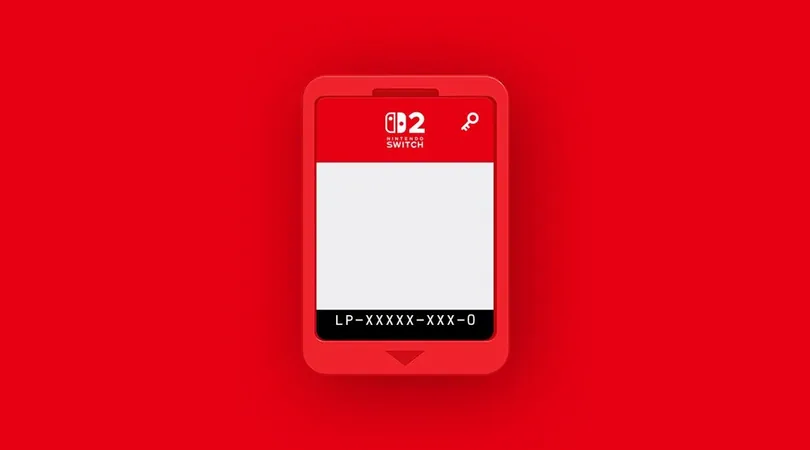
The Controversial Introduction of Nintendo's “Game-Key Cards” for Switch 2: A Blessing or a Burden?
2025-04-07
Author: Noah
The Game-Key Card: A Game-Changer or Just a Headache?
So what exactly is a Game-Key card? Unlike traditional game cartridges that are laden with game data, these cards are deceptively similar in appearance but serve a different purpose. When inserted into the console, the Game-Key card triggers a download of the game data from Nintendo's servers. Once installed, the game functions like a digital download, requiring the physical card to be present in order to play, complicating the experience compared to just playing from a standard cartridge.
This new system offers gamers an alternative to the current digital-only trend, allowing for a semblance of physical ownership while introducing a web of complexity. For instance, if you want to play your game on a different Switch system, you’ll need to download it again—consuming precious time and internal storage on your device. And in a family setting where multiple consoles are involved, this could become a tedious hurdle.
Why the Change?
It's not a secret that the gaming industry has gradually shifted toward digital distribution, where manufacturing and shipping costs are significantly lowered. Hence, the introduction of Game-Key cards may signal a last-ditch effort to offer physical options before they vanish entirely. Considering the modern trend has only been moving away from physical media, players might find themselves facing a stark reality: choose Game-Key cards or embrace digital downloads entirely.
Preservation Fears and a Digital Future
While game preservationists raise alarms about the sustainability of games tied to online servers, the stakes become even clearer when considering the fate of the Switch itself. Nintendo's history of discontinuing online services for older consoles, like the Wii U and 3DS, raises valid concerns. If the servers shut down in the future, players could be left with mere pieces of plastic—Game-Key cards without their associated games.
The community’s voices swell with frustration over these changes, particularly regarding the price point for games, which now range from $70 to $80 for new releases, and the possibility of a $449 base price for the console itself. Coupled with comparatively few first-party launch titles, the sentiment around the Switch 2's introduction has certainly had its ups and downs.
A Silver Lining?
Yet, amidst the uproar, there is a slip of light. Despite their shortcomings, Game-Key cards could serve as an alternative to a world of merely digital ownership. For gaming enthusiasts who delight in the traditional practice of lending games to friends or conserving some form of tangible property—albeit in a new shape—these cards provide a necessary link to physical ownership.
With Game-Key cards, players still hold a “thing” that can be shared or sold, unlike their strictly digital counterparts, which tie ownership strictly to an account. This persistence of physicality may provide hope for gamers who value sharing and community—a foundation upon which gaming culture was built.
Conclusion: Embracing the Change
In conclusion, while Game-Key cards carry their fair share of challenges and may signal a retreat from true physical game ownership, they could represent a compromise in a rapidly digitalizing world. It’s crucial to recognize that change is part of the industry’s evolution. Though we may long for the classic cartridge, focusing on how we can adapt to and embrace these innovations might just lead us to a more engaging gaming future.
Whether you champion the new Game-Key cards or lament the loss of true cartridges, one thing remains clear: the gaming landscape is evolving, and it will take the collective voice of players to shape its direction. So, how do you feel about these changes? Are you willing to adapt, or do you feel that physical gaming is on its last legs? Let us know!









 Brasil (PT)
Brasil (PT)
 Canada (EN)
Canada (EN)
 Chile (ES)
Chile (ES)
 Česko (CS)
Česko (CS)
 대한민국 (KO)
대한민국 (KO)
 España (ES)
España (ES)
 France (FR)
France (FR)
 Hong Kong (EN)
Hong Kong (EN)
 Italia (IT)
Italia (IT)
 日本 (JA)
日本 (JA)
 Magyarország (HU)
Magyarország (HU)
 Norge (NO)
Norge (NO)
 Polska (PL)
Polska (PL)
 Schweiz (DE)
Schweiz (DE)
 Singapore (EN)
Singapore (EN)
 Sverige (SV)
Sverige (SV)
 Suomi (FI)
Suomi (FI)
 Türkiye (TR)
Türkiye (TR)
 الإمارات العربية المتحدة (AR)
الإمارات العربية المتحدة (AR)